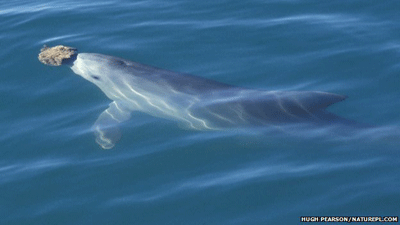 Scientists analysed data on the dolphins of Shark Bay, Australia, to model the appearance and transmission of the skill over generations.
Scientists analysed data on the dolphins of Shark Bay, Australia, to model the appearance and transmission of the skill over generations.
The study found that “sponging” could have begun with a single “innovation event” between 120 and 180 years ago.
It suggested that mothers passed on the skill by teaching their offspring.
The analysis is published in the journal Animal Behaviour, and used previous field studies to investigate how sponging was established and maintained.
“It has been thought that behaviours which are exclusively learnt from one parent are not very stable. With our model we could now show that sponging can be a stable behaviour,” said Dr Anna Kopps, a biologist at the University of New South Wales.
Watch these clever bottlenose dolphins turn the silty seabed into a fishing net
See how curious dolphins interact with a new toy: a bubble machine
Meet the dolphin as it meets itself, carefully monitoring its own appearance in a mirror
The study created a new technique to calculate the likelihood that the offspring of a “sponger” would learn the ability and pass the skill on.
By modelling the emergence of “sponger” dolphins in a computer simulation, the team could see different scenarios in which the skill could have spread among the dolphin population over the years.
They then compared the results of these simulations with field data on the genetic relationship between the spongers, to estimate the role of mothers teaching their offspring in transmitting the skill.
They found that if the likelihood of a sponger’s offspring learning the ability was less than certain, the dolphins that did pick up the technique needed to gain a survival advantage from the skill, in order for the ability to pass on to the next generation.

